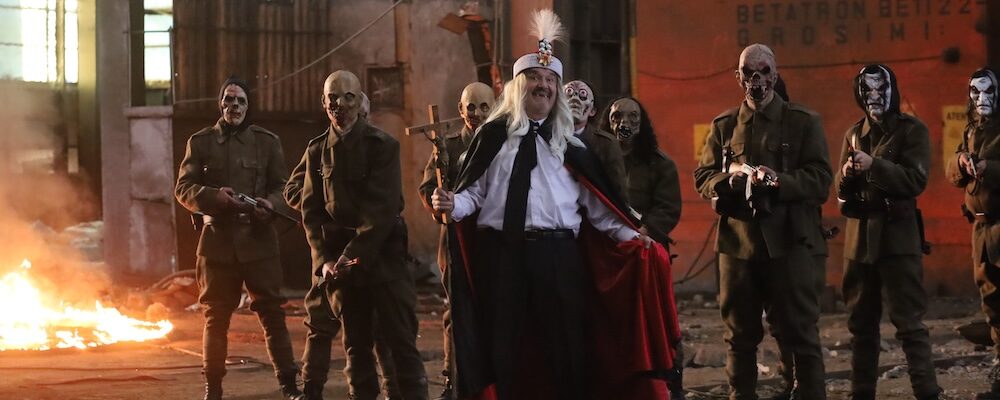Radu Jude’s Chaotic, Satiric ‘Dracula’ Anthology Is Both the Most Brilliant and Stupidest Comedy of the Year
Tony Sokol
The legend of Romania’s most renowned ruler, Vlad “The Impaler” Tepes, has been told many times. Perhaps too many. The myth, which grew from it, even more. Radu Jude, the Romanian screenwriter and director of “Dracula,” adds another dozen or so in a brilliant anthology satirizing exploitation, dictatorships, capitalism, artificial intelligence, and real stupidity. As narrator and host, Jude’s alter ego (Adonis Tanța) promises a “super commercial” film, giving viewers exactly what every Dracula movie needs: nudity, sex, feelings, violence, blood, slapstick, and car chases. “Dracula” delivers the spirit of the gag as if it is an inside joke. But we are laughing very hard on the outside.
“Dracula” follows the model set by classic comedy anthologies, like “Tunnel Vision,” “Amazon Women of the Moon,” “Groove Tube,” and “The Kentucky Fried Movie,” mixed with the irreverent sexuality of the Andy Warhol-produced, Paul Morrissey-directed underground classic, “Blood for Dracula.” The set up is a movie director (Tanța), whose new vampire film got a mediocre approval score from a test audience, asks fictional Romanian AI software “Dr. AI Judex 0.0” for new ideas. Each sequence introduction includes clever precautionary apologies for the objectionable content choices of the AI program. Besides being the best use of AI in film to date, lines about regional restrictions and political enemies are thrown like hilarious sucker punches.
The film industry feels threatened by AI encroachment. Jude lets the tech hang itself, picking the most grievous imagery to prove bad art is more fun than polished product. The practical effects, such as the cardboard cutouts in crowd scenes, are endearing, yet unsettling. Impractical FX are done on AI, and look no better than low-budget effects from the 1950s. That era, ruthlessly dominated by Romanian communist dictator Gheorghe Gheorghiu-Dej, is remembered fondly by an old actor, because he could still count on achieving an erection. This film deftly allows the desires of the powerful to trump the memories of the oppressed poor. Every offhand remark is a verbal attack thrown like a brick through a stained-glass window.
“Dracula” mixes genres, techniques, approaches, and media. Classic works from the public domain are slyly repurposed as Radu turns clips from F.W. Murnau’s “Nosferatu” into cleverly vulgar pop-up ads, an early highlight of the mixed-genre experience. The through-line story was shot entirely on an iPhone, mimicking a vacationing sightseer. In a very good singing voice with moves to match, Tanța takes on the role of emcee at an erotic cabaret show in Transylvania’s tourist district. The show is so popular it is booked for private performances, including one elite gathering rumored to include Elon Musk and Donald Trump. The lead vampire, a washed-up actor named Sandu (Gabriel Spahiu), says he would like to put a bullet in the American president’s head.
The co-star, “Vampira” (Oana Maria Zaharia), a stripper with a booming OnlyFans account, prefers her own shots. She came up through the traveling circus, and wants to keep moving. The actors’ journey trashes the blatant exploitation of the iconic Romanian despot, and a slew of more recent dictators. Any audience member at the club can buy their way to the Pink Room for an erotic encounter with a vampire. The aging actor often suffers from blood loss, and leaves angry and frustrated customers behind demanding money. They feel cheated, Sando feels exploited. The theme continues with references to the Dracula theme park proposed by the Romanian government, which turned out to be a scam.
Each segment is propelled by savagely pointed commentary. Even the silent film, designed to mimic the style of Samuel Beckett or Carl Theodor Dreyer, pours the callous indifference of the powerful into the ether, and it’s a comedy about a vampire with a toothache. “The poor should pull out their own teeth,” Dr. Caligari DDS sneers at an aching and desperate Vlad. The chapter “Das Kapital” envisions Vlad as a financial vampire, returning to life as the CEO of a gaming company front. The vicious tyrant who ruled by impaling enemies and burning the poor, reverts to type. Vlad revives the dead soldiers who fired on strikers in the 1930s to do it again. Then drains the workers dry, while his robot, again played by Tanța, goes full Christian fascist.
So much of “Dracula” is informed by Romanian dictator Nicolae Ceaușescu’s “reign of terror” from the 1970s until his overthrow in 1989. The first short, “Eutrophia,” takes place in a rejuvenation clinic which hosts wealthy patrons, including iconic Hollywood stars. A nurse mentions how Ceaușescu believed the secret treatments might make him immortal. An elderly wheelchair-bound woman finds new life in an old movie when a formerly imprisoned Vlad the Impaler walks out of the projected image of a vintage Romanian film. Their exchange of fluids is ultimately fair, and improbably funny.
After directing the darkly illuminating political satires “Bad Luck Banging or Looney Porn” and “Do Not Expect Too Much From the End of the World,” it is apparent Jude’s social commentary is rarely subtle, and always subversive. He had intended to call this film “Frankenstein,” because it is patched together but, more importantly, would cause confusion. Even with a running time of just under three hours, “Dracula” needs to be watched more than once. With sharp observations, hilariously skewered mythology, and all sorts of oral pleasure, Radu Jude delivers more than initially promised. “Dracula” may just be the funniest film of the year.
“Dracula” releases Oct. 29 in select theaters.

